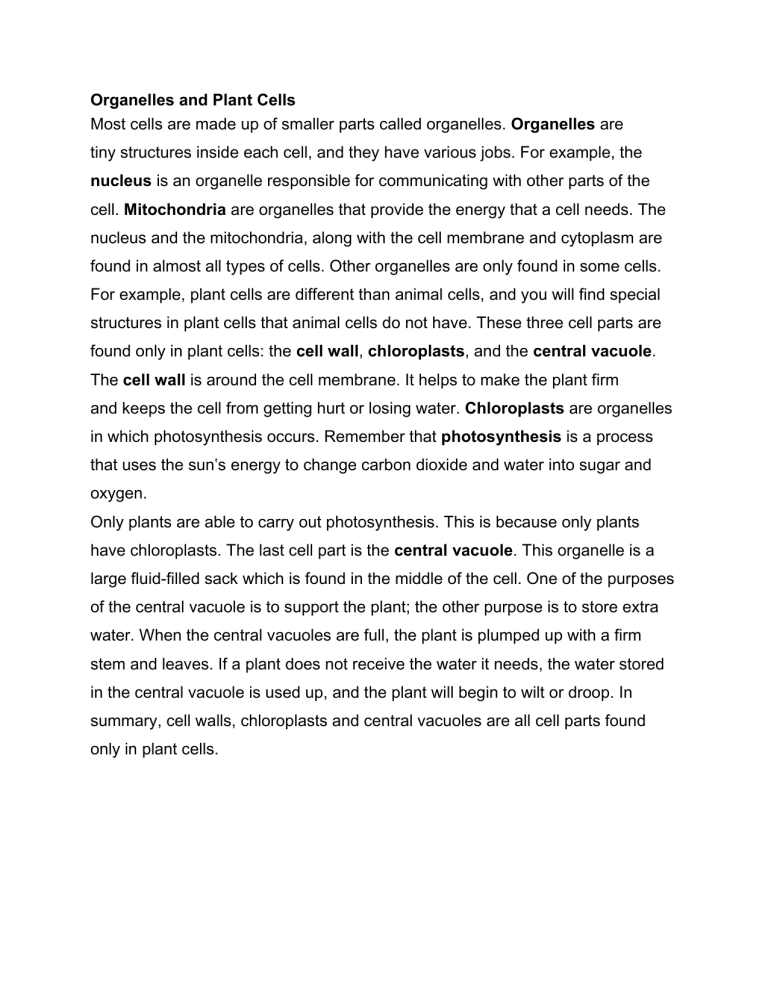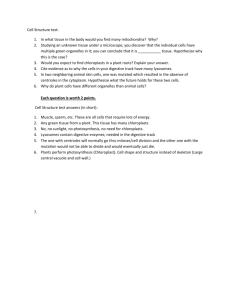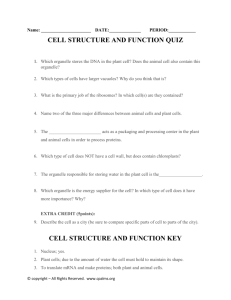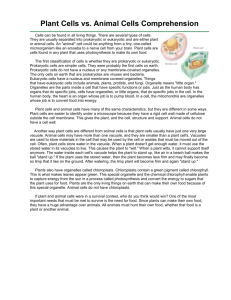Organelles and Plant Cells

Organelles and Plant Cells
Most cells are made up of smaller parts called organelles.
Organelles are tiny structures inside each cell, and they have various jobs. For example, the nucleus is an organelle responsible for communicating with other parts of the cell.
Mitochondria are organelles that provide the energy that a cell needs. The nucleus and the mitochondria, along with the cell membrane and cytoplasm are found in almost all types of cells. Other organelles are only found in some cells.
For example, plant cells are different than animal cells, and you will find special structures in plant cells that animal cells do not have. These three cell parts are found only in plant cells: the cell wall
, chloroplasts
, and the central vacuole
.
The cell wall is around the cell membrane. It helps to make the plant firm and keeps the cell from getting hurt or losing water.
Chloroplasts are organelles in which photosynthesis occurs. Remember that photosynthesis is a process that uses the sun‛s energy to change carbon dioxide and water into sugar and oxygen.
Only plants are able to carry out photosynthesis. This is because only plants have chloroplasts. The last cell part is the central vacuole
. This organelle is a large fluid-filled sack which is found in the middle of the cell. One of the purposes of the central vacuole is to support the plant; the other purpose is to store extra water. When the central vacuoles are full, the plant is plumped up with a firm stem and leaves. If a plant does not receive the water it needs, the water stored in the central vacuole is used up, and the plant will begin to wilt or droop. In summary, cell walls, chloroplasts and central vacuoles are all cell parts found only in plant cells.
1. Which two benefits does the central vacuole provide for plants?
water storage green color support communication
2. What is the purpose of an experiment?
A) to prove a hypothesis
B) to test a hypothesis
C) to demonstrate a scientific law
D) to generate material which can be published
Chlorophyll is the substance in chloroplasts that makes it possible for plants to absorb light energy. Chlorophyll is also the pigment (coloring) that makes plants green.
3.
Plants make their own food through a process called ..........................
4.
Without ................................ , there would be no life on Earth. plants water sunlight all of these
5. How do the seeds from plants spread and grow in other areas?
A) Animals carry seeds on their fur and in their digestive systems.
B) Wind and water carry seeds to new places.
C) Birds carry seeds as food and drop them along the way.
D) All of the above are ways that seeds travel.
6 – 10. Complete the chart using these words: mitochondria, chloroplasts, central vacuole, and nucleus .
Organelle Found In Job
A) plant and animal cells communicates with other parts of the cell and directs all cell activities
B) plant and animal cells provide the energy that a cell needs cell membrane plant and animal cells protects the cell
C) plant cells perform photosynthesis
D) plant cells supports the plant; stores extra water cell wall plant cells makes the plant firm and keeps the cell from getting hurt or losing water











